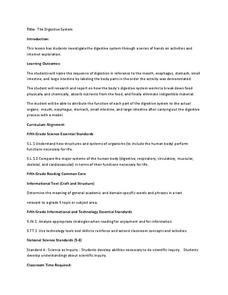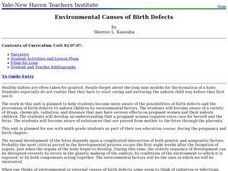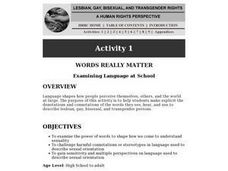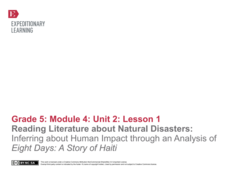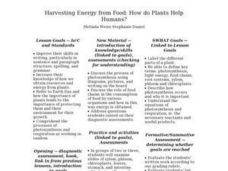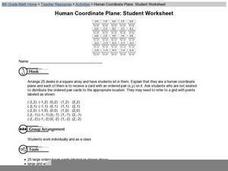Curated OER
People are People
Explore human diversity in this human rights lesson. Middle schoolers compare novels, speeches, videos, and short stories that promote diversity and basic human rights. They complete daily coursework as they read the selected literature...
Curated OER
The Digestive System
Discover how the human body's digestive system works with a brain and stomach friendly activity. Scholars taste test a variety of foods to find out how they behave once in the mouth. Class members then play a game called Move That...
Curated OER
Circulatory System
In this health worksheet, students examine the human body and make mental connections to the target function highlighted in the sheet.
Curated OER
Environmental Changes
High school scientists reasearch and illustrate changes in the local environment and consider relationships among agriculture, industry, economy, natural events, and social interactions. They construct a timeline to discover if there are...
Curated OER
Faces in the Crowd Lesson Plan
Students examine the faces of other students in the classroom and the community. They determine the similarities and the differences in hair texture and color, skin tones, shapes of noses, and eyes. Using a glue mixture, they paint the...
Curated OER
Pseudo-Holograms
Students recognize the effects of atmospheric perspective. They comprehend how human eyes perceive depth. Students create a multi-paneled drawing that shows depth and appears much like a hologram. They are told how holograms work.
Curated OER
Animals and Plants: 1st Grade Science
First graders will have a better grasp on animal characteristics after viewing this presentation. The concepts covered are, skin, life cycle, offspring, size, and human/animal interrelationships. Note: This is good as a concept review or...
Curated OER
Elsa the Lioness
Elsa is a lioness who was raised by humans in the 1950's. The Adamsons took her in after George Adamson reluctantly killed her mother. Elsa did return to the wild but maintained a very strong bond with the Adamsons until her death in...
Curated OER
Interdependence and Adaptation
Find out how camels and polar bears are each perfectly suited to their environments because of their physical adaptations. Several key features of each animal are discussed along with how those features work in their specific...
Chicago Botanic Garden
Greenhouse Gas Emissions – Natural and Human Causes
Part three in the series of seven has pupils discussing the different greenhouses gases, learning about the carbon cycle, and then watching a short video about the carbon cycle. Based on their knowledge, individuals complete a greenhouse...
Curated OER
Chalkboard Challenge: The Beginning of Human Society
After studying Ancient Civilizations, learners could use this jeopardy-like game as a review. Having questions relating to the Neolithic, Paleolithic Era, and more, this presentation would be a great whole class or center activity.
Baylor College
Need or Want?
Even as adults it can be hard to distinguish needs from wants. Using pictures of common, everyday items, children make a pocket chart separating the objects they need from those that they want. Discuss their choices, explaining that...
NASA
Engineering Design for Human Exploration
What would it take to live on the lunar surface? Small groups build model rockets in order to simulate launching a habitat into space and rebuilding it. Divide the class into groups to design and build a model of a lunar habitat. The...
Howard Hughes Medical Institute
Human Skin Color: Evidence for Selection
Skin color is controlled by at least six genes. Young scientists learn about skin colors through a documentary. They discuss the topics of pigment, natural selection, and vitamin D absorption. They apply their knowledge to higher order...
Curated OER
Environmental Causes of Birth Defects
Get your high schoolers thinking about the factors that lead to birth defects. They examine how environmental factors and personal choices can cause birth defects in unborn children. They discover the effects of various handicaps such as...
Curated OER
Words Really Matter: Examining Language at School
Help your learners gain sensitivity and become aware of the implications of the words they see, hear, and use about lesbian, gay, bisexual, and transgender people. After making lists of words or phrases they hear or use in school...
EngageNY
Reading Literature about Natural Disasters: Inferring about Human Impact through an Analysis of Eight Days: A Story of Haiti
This is a disaster. Scholars look through the book Eight Days: A Story of Haiti and discuss their wonderings about the text and natural disasters. They then complete a first read to determine gist and second read to answer...
Baylor College
We Need Water
There's nothing quite like a glass of ice-cold, freshly squeezed lemonade. Lesson seven of this series explains how the water humans need to survive can come in many forms. Teach your class about how much water humans require every day...
Curated OER
Harvesting Energy from Food: How do Plants Help Humans?
Beginning botanists view slides of plant vascular tissue. They watch Magic School Bus Gets Planted, which you can find online, and then write a summary of what they have learned about plants. This lesson could be used with upper...
Curated OER
Human Coordinate Plane: Student Worksheet
An excellent way to teach the basics of coordinate graphing is here for you! Young mathematicians take on the identity of one of the two numbers in a coordinate pair, and the entire class must arrange themselves in the proper order. This...
Curated OER
Origins: a Simple Word Game (for Use in Human Relations Trainings)
Tenth graders acquire the knowledge, attitude, interpersonal skills to help them understand and respect self and others. They participate in "Origins" as either group participants or judges. For each round, they give the common usage and...
Curated OER
Summer Body Activity: A Nose Workout
Young scholars have sensory experiences with the sweet smell of discovery. In this early childhood science lesson, students use their sense of smell as they create and compare their very own fragrance essences with a variety of provided...
Curated OER
Student Opinion: How Impulsive Are You?
Sure to spark lively discussion in any Language Arts classroom, this article from The York Times asks the question, 'How much self-control do you have?'. Pupils begin by reading a short passage about a study on delayed gratification and...
Federal Reserve Bank
What Are the ‘Ingredients’ for Economic Growth?
Delve into the concept of economic growth with your class members, including why economic growth is important, what causes it, and how can countries encourage it.
Other popular searches
- Arts and Humanities
- Humanities and Music
- Humanities and Culture
- Art and Humanities
- Integrated Humanities
- What Are the Humanities
- Humanities Ancient Greece
- Humanities Africa
- Arts Humanities
- Arts; Humanities
- Primary Humanities
- Humanities Morality Plays

